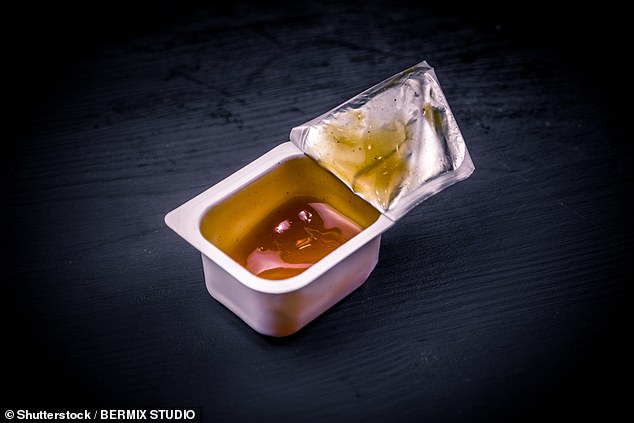Two new studies have revealed that that thousands of toxic chemicals are seeping into our bodies through every day food packaging.
Scientist from Switzerland identified 3,601 toxic chemicals in items like Tupperware, water bottles and canned goods, which were found in human blood, urine, hair and breast milk.
The chemicals included Bisphenol A, or BPA, and heavy metals that have been linked to cancer and reproductive problems.
A separate team from Brazil made another startling discovery after detecting microplastics in a part of the nose connected to the brain, which could be linked to Alzheimer’s and Parkinson’s.

The compounds infiltrate food by simply coming into contact with the product through it’s packaging or by heating up food in the plastic to-go containers handed out at restaurants.
‘There are known hazardous chemicals that are known to be linked with adverse human health outcomes, and these chemicals leach out of packaging,’ said the study’s co-author and the chief scientific officer of the Food Packaging Forum, Jane Muncke.
There are 14,000 chemicals used in packaging and the new study led by the Food Packaging Forum Foundation in Switzerland found that 25 percent of them are ‘largely unregulated.’
‘This is a staggering number and shows that food contact materials are a significant source of chemicals in humans,’ Martin Wagner, a professor of biology at the Norwegian University of Science and Technology in Trondheim told CNN.
‘The study is the first to systematically link the chemicals we use in materials to package and process foods to human exposure.’
The study, published in the Journal of Exposure Science & Environmental Epidemiology, reported that the researchers identified BPA in both food and the human body that had previously been used in baby bottles, sippy cups and infant formula containers.
The chemical remained in the products until parents boycotted it more than a decade ago, however, it is still found in other packaging containers today.
BPA has been linked to heart disease, erectile dysfunction, diabetes and cancer in adults and has also been found to increase the risk of early death by 49 percent.
Heavy metals were also discovered in the products, which can harm human’s DNA by binding proteins and displacing essential metal ions that can alter the way protein functions in the body and can cause cell dysfunction.
They can become toxic as they gradually increase and accumulate in the body and can cause cardiovascular disease, cancer and impair brain development and cause lower IQs in children.
A lesser-known item is tiny containers of sauces that are popular at fast-food restaurants.
The researchers noted that the small cups have a better chance of contaminating food because of the close proximity between the chemicals in the packaging and the products

Muncke told The Washington Post that she was recently on a flight and was giving a small container of salad dressing that raised immediate red flags.
‘They served the salad with a 15 milliliter little plastic bottle with olive oil and vinegar that you could pour over it,’ she said. ‘I thought, ‘Well, I’m not doing that.’
‘We don’t think about how the (mostly) plastic packaging adds chemicals to our food, but it’s an important source of human exposures,’ R. Thomas Zoeller, an emeritus professor of biology at the University of Massachusetts at Amherst who was not involved in the research, told The Post.
‘This is an early indication that harmful chemicals — largely unregulated — are making it into the human population.’
On top of toxic chemicals found throughout the body, a separate study also published this month was the first to identify microplastics from water bottles in the olfactory bulb.
The olfactory bulb is a small portion of tissue inside the nose that’s separated from the nasal canal and researchers found that this bulb is housing between five millimeters and one nanometer of plastic particles.
The study, published in the journal Environmental Health, found that the tissue could create a direct pathway for microplastics to enter the brain, although no published studies have confirmed the presence of PFAS in the brain.
The research team led by the University of São Paulo in Brazil said the microplastics could have reached the olfactory bulb either through systemic circulation, through the respiratory pathway or by crossing the blood-brain barrier.
Microplastics, or fragments of any plastic that measure less than five millimeters in length, lurk in oceans, the air, food, and even drinking water.
Humans constantly inhale and ingest them, raising the odds of experiencing whole-body inflammation, neurological effects, DNA damage, and a weakened immune response.
A total of 16 synthetic particles were found in eight of of the 15 deceased individuals studied.
Polypropylene – a thermoplastic found in food packaging – was the most prevalent polymer found, accounting for 48 percent of the microplastics in the bulb.
These findings could pave the way for future research to understand where microplastics originate.
Philip Landrigan, MD, who wasn’t involved with the study told MedPage Today: ‘I think there’ll be a lot more information in the next few years about how microplastics are getting into the human body — and what they’re doing once they get in there.’

